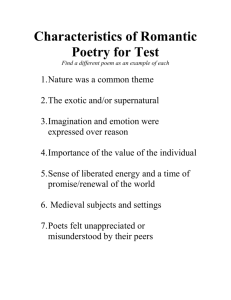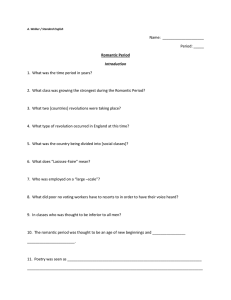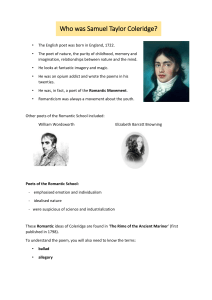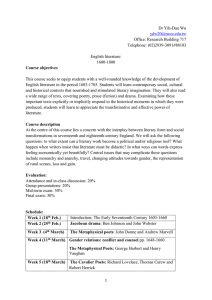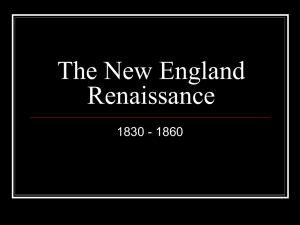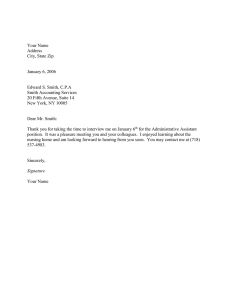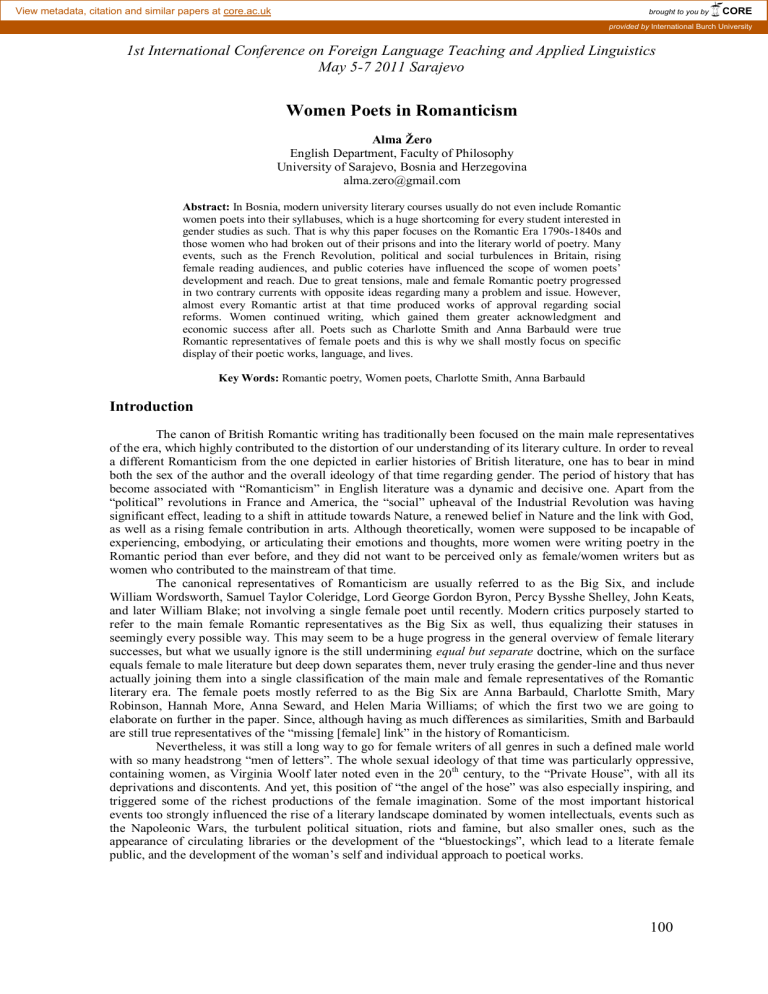
View metadata, citation and similar papers at core.ac.uk brought to you by CORE provided by International Burch University 1st International Conference on Foreign Language Teaching and Applied Linguistics May 5-7 2011 Sarajevo Women Poets in Romanticism Alma Ţero English Department, Faculty of Philosophy University of Sarajevo, Bosnia and Herzegovina alma.zero@gmail.com Abstract: In Bosnia, modern university literary courses usually do not even include Romantic women poets into their syllabuses, which is a huge shortcoming for every student interested in gender studies as such. That is why this paper focuses on the Romantic Era 1790s-1840s and those women who had broken out of their prisons and into the literary world of poetry. Many events, such as the French Revolution, political and social turbulences in Britain, rising female reading audiences, and public coteries have influenced the scope of women poets‘ development and reach. Due to great tensions, male and female Romantic poetry progressed in two contrary currents with opposite ideas regarding many a problem and issue. However, almost every Romantic artist at that time produced works of approval regarding social reforms. Women continued writing, which gained them greater acknowledgment and economic success after all. Poets such as Charlotte Smith and Anna Barbauld were true Romantic representatives of female poets and this is why we shall mostly focus on specific display of their poetic works, language, and lives. Key Words: Romantic poetry, Women poets, Charlotte Smith, Anna Barbauld Introduction The canon of British Romantic writing has traditionally been focused on the main male representatives of the era, which highly contributed to the distortion of our understanding of its literary culture. In order to reveal a different Romanticism from the one depicted in earlier histories of British literature, one has to bear in mind both the sex of the author and the overall ideology of that time regarding gender. The period of history that has become associated with ―Romanticism‖ in English literature was a dynamic and decisive one. Apart from the ―political‖ revolutions in France and America, the ―social‖ upheaval of the Industrial Revolution was having significant effect, leading to a shift in attitude towards Nature, a renewed belief in Nature and the link with God, as well as a rising female contribution in arts. Although theoretically, women were supposed to be incapable of experiencing, embodying, or articulating their emotions and thoughts, more women were writing poetry in the Romantic period than ever before, and they did not want to be perceived only as female/women writers but as women who contributed to the mainstream of that time. The canonical representatives of Romanticism are usually referred to as the Big Six, and include William Wordsworth, Samuel Taylor Coleridge, Lord George Gordon Byron, Percy Bysshe Shelley, John Keats, and later William Blake; not involving a single female poet until recently. Modern critics purposely started to refer to the main female Romantic representatives as the Big Six as well, thus equalizing their statuses in seemingly every possible way. This may seem to be a huge progress in the general overview of female literary successes, but what we usually ignore is the still undermining equal but separate doctrine, which on the surface equals female to male literature but deep down separates them, never truly erasing the gender-line and thus never actually joining them into a single classification of the main male and female representatives of the Romantic literary era. The female poets mostly referred to as the Big Six are Anna Barbauld, Charlotte Smith, Mary Robinson, Hannah More, Anna Seward, and Helen Maria Williams; of which the first two we are going to elaborate on further in the paper. Since, although having as much differences as similarities, Smith and Barbauld are still true representatives of the ―missing [female] link‖ in the history of Romanticism. Nevertheless, it was still a long way to go for female writers of all genres in such a defined male world with so many headstrong ―men of letters‖. The whole sexual ideology of that time was particularly oppressive, containing women, as Virginia Woolf later noted even in the 20th century, to the ―Private House‖, with all its deprivations and discontents. And yet, this position of ―the angel of the hose‖ was also especially inspiring, and triggered some of the richest productions of the female imagination. Some of the most important historical events too strongly influenced the rise of a literary landscape dominated by women intellectuals, events such as the Napoleonic Wars, the turbulent political situation, riots and famine, but also smaller ones, such as the appearance of circulating libraries or the development of the ―bluestockings‖, which lead to a literate female public, and the development of the woman‘s self and individual approach to poetical works. 100 1st International Conference on Foreign Language Teaching and Applied Linguistics May 5-7 2011 Sarajevo Method of the Study The paper was accomplished by using the qualitative approach, since the study focuses on a more indepth analysis and understanding of the overall ideology, situation and experiences of women poets in the Romantic period and not on specific results of an experimental research. The techniques and procedures that we used are analysis of bibliography, email and internet surveys, as well as observation of students' reaction regarding the lack of female poets in literary courses. Apart from that, we used the comparative method so as to gain insight into the opposite positions, as well as similarities of male and female poets during Romanticism. On top of that, we used theoretical sampling (Glaser and Strauss, 1067) which is defined as the process of selecting "incidents, slices of life, time periods, or people on the basis of their potential manifestation or representation of important theoretical constructs" (Patton, 2001). Thus, the lives and works of Charlotte Smith and Anna Barbauld were used to portray some of the findings regarding the Romantic period and its characteristics. Findings and Discussion Female Readers In the 1780s British booksellers had started lending books in available libraries, thus for the first time enabling the literate middle classes (women as well as men) to purchase books. But since the middle and upper class women seemed to have had more leisure time to read, it is they who became by 1800 the primary market for works of literature. Most popular women poets published their works in magazines, gift-books, and annuals read by an ascending female critical mass. One of the main disadvantages of contributing to such literary sources was the limitation set by ―a circumscribed domain of acceptable literary femininity, writing from the heart about heart‘s concerns‖ (Gilroy, ―Women Poets 1780-1830‖, Romantic Writings, ed. Bygrave, 1996) which certainly influenced the quality of writing. However, the forming of a new (female) reading audience was seen by many male critics and writers as a cultural threat on several accounts. First, female readers might trivialize literature, which basically underestimates the intellectual capacity of women and contrasts the general notion about a woman‘s ―vulgar taste‖ with a (gentle) man‘s highly educated sense for aesthetics. Second, ―female reading was increasingly regarded as a dangerous recreation‖ (Mellor, 2005) during the Romantic period, to put it in the words of Jacqueline Pearson who wrote about it in her book Women‘s Reading in Britain 1750-1835 (1999). A dangerous recreation that could probably lead to increased rationality while exposing women to ―unfeminine‖ new ideas and forbidden sexual desires. Apart from that, a woman was never to be distracted from her usual domestic duties, which reading certainly did in the strict eyes of those advocating the whole oppressive sexual ideology of that time. Third, and perhaps the most important fact is that, since women preferred to read works of general information written by other women, they, as the leading audience, provided a large market for women writers. Thus, every female reader supported female writers, consciously or not, which leads us to a cultural and intellectual phenomenon that we mentioned at the beginning of the paper – the bluestocking circle. The Bluestocking vs. the Poetess By the late eighteenth century, there were many circles of learned women supporting and educating other females in order to improve the general opinion, as well as to come to terms with different occupations apart from the well-known ―motherly housewife‖. Those educated women were known as the ―bluestockings‖, which is a reference to informal blue woolen stockings as compared to formal black silk ones. Thus, the emphasis was greatly put on the informal quality of the gatherings and on conversation over fashion, which was generally unthinkable of in any female circle until then. Nevertheless, the Bluestocking Society certainly set itself no intellectual limitations: they debated moral questions, translated the classics, and engaged in influential literary criticism. It was founded by Elizabeth Montagu, a British literary critic and writer, in the early 1750s, and it had a huge impact on the works and reception of women poets, since the Society gave emotional and intellectual support and, what was of even greater importance, an economic one as well. Nevertheless, one of the main drawbacks for these women was the male portrayal of their disturbing unfeminine existence, which is most impressively depicted in an essay by the Scottish author and poet George Gilfillan on Felicia Hemans in Tait‘s Edinburgh Magazine (thus available to any man, woman, or child, imposing its negative connotations and spreading the ideology). The bluestocking observed and portrayed in this excerpt is, not only improperly dressed and ―ludicrous‖ (Gilroy, 1996), because she attempts to transcend into spheres not ―proper‖ (Gilroy, 1996) for her, but she is also 101 1st International Conference on Foreign Language Teaching and Applied Linguistics May 5-7 2011 Sarajevo extremely unfeminine. The belittling depiction of her with all the papers (referring to hair curlers, rather than literary works) and sweat that she spills over her work, for which she obviously does not need a lot of time (―from morn to noon‖) (Gilroy, 1996) and which is thus not nearly as qualified as literature written by men, puts a strong emphasis on a woman‘s femininity. Many of the concerns that Gilfillan points out in this mockhumiliating essay of his, were the actual issues early women poets had to fight. As might be expected in this age, ―the more conservative the viewpoint, the more likelihood that the writer would be lavishly praised, widely read, and therefore all the more capable of attaining independence‖ (Curran, 2000), independence that women writers eagerly expected. And yet, the more a woman sought independence, the more she was criticized, and the more a woman tried to submit, the more she was ridiculed. Gilfillan underlines the importance of propriety of women‘s poetry, her femininity, and her heart, meaning her psychological and emotional state of mind, not the intellectual and educative one. These characteristics were widely used to describe the poetess, the woman confining her works to the feminine spheres, the caretaker of morality and religious responsibility, ―the good housewife of literature‖ (Gilroy, 1996). Those women poets were not generally perceived as an actual threat to the man‘s spheres of literature, since their writings are ―unstudied‖, as Gilfillan observed, thus highlighting the limits of both female intellectual capacities and feminine inspiration. The role of the poetess is viewed as simply another role that the housewife takes on while happily managing the household, and, although bluestockings never agreed with poetesses on several accounts, it was still publicly ―better‖ for a woman to live up to such expected ideals. Since Felicia Hemans certainly was a perfect example of a poetess, Gilfillan chose her as the image to emulate for other female poets, what many actually did, such as Letitia Elizabeth Landon (L.E.L.) or Elizabeth Barrett Browning, who were above all clever businesswomen as well. Contrary Currents The canonical male poets of the Romantic period were concerned with the capacities of creative imagination, with the development of an autonomous self, capable of transcendental thoughts and quality of life, and, later in the same period, with the individual approach and critique to social and political institutions, as well as with revolution as a conceptual idea or practical realization. Although merely an overview of the main issues, it certainly does help us in underlining the few similarities and many differences between Romantic male and female poets. Women poets, such as Charlotte Smith, Anna Barbauld, Mary Robinson, or Hannah More, strongly defended their position on the use of the, in Wordsworth‘s words, ―language of men‖ (Dizdar, 1999), since, as they claimed, it was the language that women usually used while concerned with the vernacular, with the ordinary, i.e. with the quotidian qualities of that time. The very word quotidian basically means ―the daily, ordinary, common‖ (The Free Dictionary, 2009), and was used as a reference to the daily domestic and social involvements. Women poets wrote the so called sentimental poems, back then a very fashionable style, on personal occasions such as the birth of a child and argued that in commenting on the small occurrences of daily life, they would establish a moral foundation for the nation. Another difference between the female and male Romantics is their position on, or better to say, their portrayal of the French Revolution, since both male and female writers never accepted war as a beneficial solution in general. While men involved themselves into writing elaborate poems and papers on the lost heroic portrayals of battles and warfare, such as Byron in his ―Childe Harold‘s Pilgrimage‖ (1812-1818) does (―And Harold stands upon this place of skulls, / The grave of France, the deadly Waterloo!‖) (Dizdar, 1999), women wrote about its uselessness and the despair in domestic areas, heavily relying on the above mentioned sentimentalism. They highlighted some of the most important issues that evolved out of the whole turbulent period, issues that concerned the society as such, but mostly emphasizing the state in which women were forced to change their minds or states. One of the most vivid depictions is written by Mary Robinson in her remarkable poem ―Winkfield Plain; or, a Description of a Camp in the Year 1800‖ (1804): ―Drums and trumpets, singing, firing / Girls seducing, beaux admiring… / Public-houses, booths, and castles… / Perfum‘d, painted, patch‘d, and blooming / Ladies – manly airs assuming! ... / Dames heart sick of wedded sameness… / All confusion, din, and riot, / Nothing clean – and nothing quiet. ‖ (Curran, 2000) Robinson employs to full effect both the feminine rhyme and present participle (―firing‖, ―admiring‖, ―blooming‖, ―assuming‖), a device generally used by her, so that the diversity and the restless energy of this temporary city (a camp) are strongly suggested. Curran (2000) states that the quotidian is absolute, since Robinson engaged herself into the ordinary and actual daily lives of lower and upper classes, never posing categorizations of any kind. She is one of the many women who have written about the place of a woman in wartime, about her domestic hardships (―public-houses‖, ―heart sick‖, ―wedded sameness‖), as well as about the 102 1st International Conference on Foreign Language Teaching and Applied Linguistics May 5-7 2011 Sarajevo prejudices and judgments she had to face (―manly airs assuming‖) by occupying herself with what were supposed to be male spheres, including writing poetry (such as she herself did by writing this very poem using such controversial topics). Apart from the portrayals of wartime situations, men and women poets slightly contrasted in that the men embraced the call for the overthrow of the British monarchy and the creation of a democratic republic, such as Shelley did in ―Prometheus Unbound‖ (1820) (―The loathsome mask has fallen, the man remains/ Sceptreless, free, uncircumscribed, but man/ Equal, unclassed, tribeless, and nationless,/ Exempt from awe, worship, degree, the king/ Over himself‖) (Dizdar, 1999), while women disagreed on how this social change is to be achieved. Women poets argued, publicly as well as through their works that a sudden and violent political revolution takes too many casualties. They thought that a social reform is a process, ―not of revolution but of gradual evolution, a process that is furthered by educating the populace‖ (Mellor, ―Feminism‖, Romanticism, ed. Roe, 2005) In A Vindication of the Rights of Woman (1792), Mary Wollstonecraft argued that women were not to be observed only as passive objects of literary works, since every woman has the capability to think for herself, as well as to write what she thinks (and not only what she feels); concluding with a demand for improved education of women. She emphasized the importance of women being educated in the same schools in which men were educated, and for the same purposes – to legally participate in the nation‘s improvement. Many women writers insisted on the motherly role that they were given much earlier by their male counterparts, arguing that they were better suited to rule the nation than men because of these natural instincts to protect and care for the family (nation in this case). In that way, women started to use the sexual ideology of the time for their own individual or collective purposes; a true ―act of liberation through, not from, femininity‖ (Curran, 1996). Apart from that, women gain a quite opposite perspective of nature in relation to that of male poets. While men perceive nature as the source of divine creative power, the power of God (or the universe), the source of a ―spontaneous overflow of feelings‖, which he speaks for and understands; women poets denounce this concept of the sublime, the mental empowerment, and see her as Mother Nature, a female friend who provides support but needs cultivation. The woman poet either merges with her relational self, as opposite to the autonomous self of the male Romantic poet, and she focuses on the ways in which that self interacts with her surroundings and the wider community; or, she retreats into a desolate state of mind, reinforcing the rising cult of sensibility. This very cult is strongly related to Sentimentalism from the 18th century, which puts an emphasis on feelings and emotions, a physical appreciation of God, nature, and other people, as well as on the ability to project those thoughts and ideas onto the reader by evoking sympathy, self-awareness, or sensitivity. The above mentioned relational self is related to one of the main traits of Sentimentalism itself, thus being an extension on what sentimentalists used to call the ―sentimental female persona‖, a persona able to connect with others, or herself, and to express her deepest emotional fears despite consequences of humiliation and failure. ―The Missing Link‖ Charlotte Smith As the most famous English female poet at the end of the eighteenth century, Charlotte Turner Smith (1749-1806) encompasses some of the above mentioned most important traits characteristic to, as some critics named it, the Feminine Romanticism. Her Elegiac Sonnets of 1784 went through ten expanding editions in fifteen years. It was Smith, and her fellow female poets, who strongly impelled the revival of the sonnet, since they avoided the form of the epic and mostly wrote sonnets, ballads, or lyrics. These forms enabled them to express their own feelings and arouse sympathy of their readers, while memorizing an ongoing relationship or the lack of it, such as did Smith in her own sonnets. Charlotte Smith vigorously invoked the vernacular, ordinary language, as well as the already mentioned quotidian values, e.g. in her fantastic world of ―Flora‖ (Beachy Head and Other Poems, 1807): ―The vision comes…/ Flora descends, to dress the expecting earth,/ Awake the germs, and call the buds to birth;/ Bid each hybernacle its cell unfold, / And open silken leaves, and eyes of gold! (Smith, ―Flora‖, The Poems of Charlotte Smith, ed. Curran 1993) While portraying the quotidian, a simple garden, in terms of a fairyland; Smith certainly uses the typical poetry of vision which we refer to not always realizing the paradoxical meaning it has. The actual vision does not have to be the metaphorical poeticizing, but an actual vision in the form of a province, or, as we could see, a garden. While Smith repeatedly demonstrated her maternal devotion in the first part of her Elegiac Sonnets, in ―Flora‖ she subtly puts an emphasis on the feminine qualities of Flora, the goddess of flowers and the season of spring in Roman mythology. Flora is a ―vision‖ herself, compelling the reader to imagine an extraordinarily beautiful woman, a woman that employs herself with a mother‘s daily routine: she dresses the earth and awakes 103 1st International Conference on Foreign Language Teaching and Applied Linguistics May 5-7 2011 Sarajevo the germs like a mother would dress and awake her children in the morning. Flora is at the same time a vision of fertility, the goddess, the woman giving birth to the buds, evokes life, the renewal of the cycle of life, and thus highlighting the woman‘s essential role in human reproduction while at the same time underlining the importance of the feminine touch as in ordinary so in extraordinary spheres of life. Smith‘s hidden message is related to a woman poet‘s position in her own time; a woman poet‘s potential to open the society‘s ―eyes of gold‖, of knowledge, independence, respect, and awareness, instead of those shut by judgment and false ideologies. As already mentioned, many of the Romantic women poets used the sexual ideology of their time for their own purposes; Charlotte Smith was no exception. She used her suffering, her concern for her children, and even the humiliating ―exile‖ husband as poetic inspirations and conveyed her self-pity on paper. In a letter to her bookseller Thomas Cadell, she writes: ―I cannot but murmur at my fate, which seems the hardest that ever was endured & the most irremediable‖ (Taylor, 1994). Pity and self-pity turned out to be the major theme that she ever used in her poetical works, as a source of inspiration, as well as self-advertisement. The already mentioned rising cult of sensibility gave women a certain feeling of advantage, since emotions were generally related to femininity, thus, emotion and its projections transformed female writings, which finally lead to some kind of a ―Neo-Sentimentalism‖ and its upholding of empathy and introspection, as in the following poem by Charlotte Smith. In ―Sonnet XXXII. To Melancholy. Written on the Banks of the Arun, October 1785‖, Charlotte Smith explores the limits of the tragic emotion of pity and sadness, but at the same time she smoothly draws on works of former poets, such as Thomas Gray and Thomas Otway. The speaker‘s somber pensive mood is reflected in the haunted landscape‘s description, which partly reminds us of mid-eighteenth century ―graveyard school of poetry‖ and especially of Gray‘s ―Elegy Written in a Country Churchyard‖ (1751) with the melancholic, vulnerable, and sensitive poetic persona. In that way, Smith displays the quality of sensibility, fashionable for women poets at that time, and it provides a poetic persona whom the poet herself can identify with. At the end, Smith once again surprises the reader with her positive use of negative experiences and emotions: ―Oh Melancholy! such thy magic power,/ That to the soul these dreams are often sweet,/ And soothe the pensive visionary mind!‖ ((Smith, ―Sonnet XXXII‖) It is this pensive and sad emotion that the poet draws upon and develops her imagination, and it is this very state of mind and heart that provides her with the skill to write verses such as the above mentioned. While relying on these sensible and vulnerable emotions, Smith heavily drew upon her representation as a mother. Nevertheless, it is not the later commercialized ―moral motherhood‖ of the nineteenth century but one that concerns itself with the systematic subjugation of women, thus being able to sympathize with the subjugation of any other person or people. She displayed vigorous sympathy for the liberation of the French people, that it earned her a good reputation and reception among the British living in Paris. Her poem ―The Emigrants‖ of 1793 was a dedication to William Cowper, since she admitted to have used his ―The Task‖ (1785) as her model for the use of ―a poetic style in which the inner musings of an isolated sensibility, through intertwining strands of association, define an arena for desultory contemplation and surround it from various directions at once‖ (Curran, 1994). Smith develops the already mentioned relational self, and corresponds as a solitary figure to the French exiles and their loss, thus creating her own identity by absorbing their experiences of injustice and despair: ―Still, as Men misled By early prejudice (so hard to break)/ I mourn your sorrows; for I too have known/ Involuntary exile.‖ (Smith, ―The Emigrants‖) The very absorption of another person‘s emotion or experience is a typical trait of Sentimentalism, since the resulting empathy and impact on one‘s own self is the main source of inspiration and self-reflection. Apart from that, the implications of ―early prejudices, so hard to break‖ are more than apparent if observed in relation to the oppressive state in which women had to live, where their legal existence was attached to that of her husband, but even more, where an educated woman‘s hardships to confront male prejudices were socially neglected. But the main difference between Cowper and Smith is his moralistic tone, which, although she writes ―Learn, that the God thou worshippest, delights/ In acts of pure humanity!‖ (Smith, ―The Emigrants‖), further in the poem, she praises revolutionary actions by those who fight for their rights and freedom: ―Actions such as these,/ Like incense rising to the Throne of Heaven,/ Far better justify the pride, that swells/ Of Victory from a thousand brazen throats‖ (Smith, ―The Emigrants‖). Even her representation of natural otherness in ―The Emigrants‖ is strongly influenced by her admiring the concept of renewal (e.g. the change of seasons); something which people can admire but not participate in, such as portrayed by William Wordsworth himself in ―The Solitary Reaper‖ (Poems, in Two Volumes, 1807). Wordsworth paradoxically describes his inability to describe the unearthly song sang by a Scottish Highlands girl as she reaps grain in a solitary field. He compares the girl to a nightingale singing an incomprehensible song, which reminds us of Keats‘s ―Ode to a Nightingale‖ (1819) or even more to Shelley‘s ―To a Skylark‖ (1820), 104 1st International Conference on Foreign Language Teaching and Applied Linguistics May 5-7 2011 Sarajevo which devotedly emphasizes the bird‘s divine and transcendental qualities (―What art thou we know not; / Until we hardly see – we feel that it is there.‖) (Shelley, ―To a Skylark‖), implying its inspiring effect on the poet, along with the human inability to reach the bird‘s freedom and carelessness, and by deeper analysis, human hopelessness in terms of natural processes and necessary changes. Nevertheless, many critics think that Smith‘s ―Beachy Head‖ (1807) is by far her greatest artistic achievement when considering the representations of nature. She perfectly conveys her idea that no mind nor linguistic system can imagine or utter the power, infinity, and variety that nature encompasses, thus people, not even elevated poets, are capable of understanding her, not to mention of speaking for her (as Romantic poets usually claimed to). Beachy Head is actually a long headland, whose human and geological history becomes the subject of this narrative poem. Some controversies arouse regarding the connotations of French invasion of England in the poems, as well as the fact that the self-pity and lament are briefly referred to with the question ―Ah, who is happy? [and the answer some thirty lines later] ―I once was happy‖ (Smith, ―Beachy Head‖). Because of this very remoteness and absence of Smith herself, many critics argued that the poem itself is more of a historical importance than elegiac one. Anna Barbauld In the Memoires devoted to Anna Laetitia Barbauld (1743-1825), Lucy Aikin wrote: ―That swiftness of apprehension by which she [Barbauld] was eminently distinguished, manifested itself from her earliest infancy‖ (Aikin, 1826). It is thus sad that a student of British Romanticism cannot find more than two or three books on this great female poet of the Romantic period. She was not only one of the most notable contributors to Romantic poetry; she was also one of the many women poets that proved themselves in favor of a gradual social reform. Anna Barbauld published her ―Epistle to William Wilberforce‖ on the evils of Slave Trade, under her own name, thus sympathizing with the abolitionist movement; but she also anonymously published some political orations with such a strong command that it seemed incredible to all when they realized that it was written by a woman. Although confined to a woman‘s sphere from early age on, she certainly knew how to use her situation in order to gain independence, such as the already mentioned Charlotte Smith did. In Stuart Curran‘s words, ―if a woman‘s place is in the home, or in the schoolroom as in Anna Barbauld‘s case, or in the garden, then the particulars of those confined quarters are made the impetus for verse‖ (Curran, 1996). Barbauld herself used the quotidian or the ordinary as the driving force for her literary verses, thus the titles of three of her poems are very indicative of it: ―Verses Written in an Alcove‖ (1773), ―An Inventory of the Furniture in Dr Priestley‘s Study‖ (1825), or even ―The First Fire, October 1st, 1815‖ (1825). But she was also a headstrong Dissenting writer who eagerly advocated the role of the Dissenters (English Christians who for one reason or another separated from the Church of England) in the future of Britain, since it was for her the faith and education of progress. Beyond the Dissenting intellectual community, she relied on the circle of cultured ―bluestockings‖ to whom her Poems of 1773 introduced her and who immediately embraced her as an articulate representative of their values (which we already explored in detail). She criticized Romantic reviewers‘ for increasingly emphasizing the connection between a woman‘s life and her text as a way of enforcing contemporary ideologies of femininity, such as in her poem ―On a Lady‘s Writing‖ (Poems, 1773): ―Her even lines her steady temper show;/ Neat as her dress, and polish'd as her brow;/ Strong as her judgment, easy as her air;/ Correct though free, and regular though fair:/ And the same graces o'er her pen preside/ That form her manners and her footsteps guide‖. Barbauld amazingly conveys to the reader an image of a perfect lady in just six lines, thus emphasizing the difficulties which a woman poet had to deal with. A woman was supposed to be the caretaker of morality and good manner, and so was her poetry (if any) expected to literally look like, and even sound. The neatness of meters and syllabic uses was to be matched with a polished (artificial) language, thus enhancing the ―propriety‖ of a woman‘s conduct in every possible sphere of her life. Some of Barbauld‘s comments on the French Revolution were extremely judged, and even any possible allusion on rebellious thoughts was generally forbidden. For example, the suggestion in her collection of poems Hymns in Prose (1781) that a king could act wrongly and be punished by God becomes much more uncomfortable at such a time. Barbauld was a devotee to the cult of sensibility, which gained momentum once women poets realized that they can gain certain authority by using their main ―defect‖, femininity, as a distinguishing virtue. Thus, in her poem ―The Mouse‘s Petition. Found in the TRAP where he had been confin'd all Night‖ (Poems, 1773), Barbauld reflects on herself, on human relations among themselves and to the natural environment with all its creatures. She actually wrote the poem as a response to Joseph Priestley‘s scientific experiments on animals, especially on a mouse that was caught in a trap the very night when Barbauld visited him. According to some critics, the poem was found ―twisted among the wires of the cage [of the mouse] the next day when it was brought in after breakfast‖ (Bellanca, 2003). Even Samuel Taylor Coleridge, who wrote ―The Rime of the Ancient Mariner‖ (1798), admired her sensibility, and wrote: ―thanks to Mrs. Barbauld, . . . it has become 105 1st International Conference on Foreign Language Teaching and Applied Linguistics May 5-7 2011 Sarajevo universally fashionable to teach lessons of compassion towards animals‖ (Bellanca, 2003); but ―The Mouse‘s Petition‖ was more than just a plea against animal experimentation, in many ways comparable to the poem ―To a Mouse, on Turning Her Up in Her Nest, With The Plough‖ (1786) written by the self-proclaimed bard of Scotland, Robert Burns. While introducing the reader with his knowledge of agriculture and farming, Burns underlines the importance of sympathy even in the daily monotony of a simple farmer and the possibility of the farmer‘s usurping the natural environment: ―I‘m truly sorry Man‘s dominion / Has broken Nature‘s social union‖ (Burns, ―To a Mouse‖). Due to the fact that the whole idea Barbauld had is projected in Burns‘s poem, it is not surprising that he used some of her words such as ―beastie‖, but Barbauld‘s constant refusal to use any particular gender, except in the last lines, enables both male and female readers to sympathize with the animal and nature itself. With lines such as: ―Lets Nature commoners enjoy/ The common gifts of Heaven‖ (Barbauld, ―The Mouse‘s Petition‖), Barbauld speaks for general women rights downtrodden by their male contemporaries and competitors, for any detained and oppressed human, and for such liberty as required by nature‘s laws. In that sense, Barbauld defied imprisonment of any kind, psychological or social, as well as the constant human urge to subdue nature under its control: ―The well-taught philosophic mind/ To all compassion gives;/ Casts round the world an equal eye,/ And feels for all that lives.‖ (Barbauld, ―The Mouse‘s Petition‖) Barbauld contrasts the feminine sensibility against male rationality, and skillfully encompasses both ―the philosophic mind‖ and ―compassion‖, which basically is a combination of the already mentioned contrary literary currents, but a combination of human states of mind and heart as well. She was a firm advocate for a better educational system for women, especially in the areas of natural science, since all (male and female) human beings need a better understanding of the scientific approaches to natural processes. Barbauld ironically concludes that whatever happens to an animal, a mouse in this case, can easily happen to humans as well (―which men, like mice, may share‖) (Barbauld, ―The Mouse‘s Petition‖); a message similar to Burns‘s: ―The best laid schemes o‘ Men an‘ Mice / Gang oft agley‖. (Burns, ―To a Mouse‖) On one hand, it is natural catastrophes that could destruct a whole nation; on the other hand ―destruction lurks unseen‖ (Barbauld, ―The Mouse‘s Petition‖) and usually as a consequence to humans of their own cruelty (wars, oppressions, executions). The main difference between these two great poets is Burns‘s concluding with the acceptance of an animal‘s inferiority due to its lack of reason and its experiencing any hardship only at the very moment of it (―the present only toucheth thee‖) (Burns, ―To a Mouse‖), while Barbauld, reflecting her own inferior position as a writer, discovers a ―kindred mind‖ in the ―free-born mouse detain[ed]‖ (Barbauld, ―The Mouse‘s Petition‖) and nature‘s environment in general. Conclusion Women in patriarchal societies have historically been reduced to not more than just properties, to characters in fairy tales and images imprisoned in male texts because generated only by male expectations and ideas. This paper focused on women poets in the Romantic Era 1790s-1840s, those women who had broken out of their prisons and into the literary world of poetry. Many events, such as the French Revolution, political and social turbulences in Britain, rising female reading audiences, and public coteries (e.g. The Bluestocking Society) have influenced the scope of women poets‘ development and reach. Apart from their general appeal to female readers, women poets had to confront the increasing hostility on the part of the male Romantic writers and artists. Due to this tension, male and female Romantic poetry progressed in two contrary currents, with, raging from slightly to extremely, opposite ideas of the poetic language and topics and the political and social implications of revolutionary uprisings. While women were supposed to write in a manner which mirrors their female domestic qualities, men claimed the ―masculine rationality‖ for them. However, almost every Romantic artist at that time produced works of approval regarding social reforms; women focusing on the gradual evolution, and men mostly confirming to the sudden revolution. Whatever the drawbacks or prejudices, women continued writing, developing a relational self devoted to the cult of sensibility, which gained them greater acknowledgment and economic success after all. Poets such as Charlotte Smith and Anna Barbauld were true Romantic models to emulate, and several of their most famous poems, such as ―Beachy Head‖ and ―The Mouse‘s Petition‖ respectively, are the richest productions of female imagination. They devotedly proved to be ―unacknowledged legislators of the world‖. 106 1st International Conference on Foreign Language Teaching and Applied Linguistics May 5-7 2011 Sarajevo References Ashfield, Andrew, ed. Romantic Women Poets, 1770-1838: An Anthology. Manchester: Manchester University Press, 1995. Barbauld, Anna. The Works of Anna Barbauld. Ed. Aikin, Lucy. Boston: David Reed, 1826. (Digitized Version in 2007.) Brydges, Egerton. Imaginative Biography. London: Saunders and Otley, 1834. (Digitized Version in 2008.) Bygrave, Stephen, ed. Approaching Literature: Romantic Writings. Curran, Stuart. ―Romantic Poetry: The I altered‖. London: Routledge (in association with the Open University), 1996. Curran, Stuart. The Cambridge Companion to British Romanticism. Cambridge: Cambridge University Press, 2000. Curran, Stuart. Essay: Romantic poetry: Why and wherefore? Dizdar, Srebren. Poezija engleskog romantizma. Sarajevo: ―ŃahinpańiĤ‖, 1999. Gilbert, Sandra M., Gubar, Susan. The Madwoman in the Attic: The Woman Writer and the Nineteenth-century Imagination. New Haven and London: Yale University Press, 1984. Roe, Nicholas, ed. Romanticism: An Oxford Guide. Mellor, Anne K. ―Feminism‖. Oxford: Oxford University Press, 2005. Smith, Charlotte. The Poems of Charlotte Smith. Ed. Curran, Stuart. Oxford: Oxford University Press, 1993. Stanton, Judith Phillips. The Collected Letters of Charlotte Smith. Bloomington, IN: Indiana University Press, 2003. Woolf, Virginia. Selected Works of Virginia Woolf. London: Wordsworth Editions, 2005. Van Leeuwen, Steven H. Bartleby.Com:Great Books Online. 1999. URL: http://www.bartleby.com/ The Free Dictionary. Huntingdon Valley, PA: Farlex, Inc., 2006. URL: http://www.thefreedictionary.com/ Articles used from JSTOR (Journal Storage): Richard C. Taylor and Charlotte Smith, "The Evils, I was Born to Bear": Two Letters from Charlotte Smith to Thomas Cadell, Source: Modern Philology, Vol. 91, No. 3 (Feb., 1994), Published by: The University of Chicago Press, URL: http://www.jstor.org/stable/438436 Stuart Curran, Charlotte Smith and British Romanticism, Source: South Central Review, Vol. 11, No. 2 (Summer, 1994), Published by: The Johns Hopkins University Press, URL: http://www.jstor.org/stable/3189989 Paula R. Feldman, Women Poets and Anonymity in the Romantic Era, Source: New Literary History, Vol. 33, No. 2, Anonymity (Spring, 2002), Published by: The Johns Hopkins University Press, URL: http://www.jstor.org/stable/20057724 Mary Ellen Bellanca, Science, Animal Sympathy, and Anna Barbauld‘s ―The Mouse‘s Petition‖, Source: Eighteenth-Century Studies, vol. 37, no. 1 (2003) 107 1st International Conference on Foreign Language Teaching and Applied Linguistics May 5-7 2011 Sarajevo Theresa M. Kelley, Romantic Histories: Charlotte Smith and "Beachy Head", Source: Nineteenth-Century Literature, Vol. 59, No. 3 (Dec., 2004), Published by: University of California Press, URL: http://www.jstor.org/stable/4142003 Emma Major, Nature, Nation, and Denomination: Barbauld‘s Taste for the Public, Source: ELH, Vol. 74 (2007), Published by: The Johns Hopkins University Press 108
